Missile Works WRC2 (Wireless Recovery Controller)
Missile Works - WRC2 (Wireless Recovery Controller)
Contributed by Al Casper
| Published: | 2010-11-13 |
| Manufacturer: | Missile Works  |
Missile Works - WRC² review is provided courtesy of: By: Al Casper The receiver board is rather large (Fig-3) measuring 5.5" L x 3.25" W x 1" H. and weighs 2.8 ounces without the battery. The receiver board will not fit into an airframe smaller than 4" in diameter. The antenna is built into the board so there are no dangling antenna wires to worry about. The receiver requires 11 to 14 volts DC and draws 40ma. The instructions do not have any suggestions for this battery at this time. Jim Amos of Missile Works is looking for a suitable 12 volt rechargeable battery for the system. For events requiring very high current, possibly the igniter in a second stage motor, it is recommended that the receiver be wired for dual batteries, one for the receiver and one dedicated to the output. This configuration is fully covered in the manual and assures the receiver will have adequate power to continue operation for the second event after a heavy current drain by the first event. I have used the WRC² successfully on two test flights. At the Danville '99 launch, my Allegro Vivace (Fig-6), a 5.5 inch scratch built 9 foot tall Hybrid powered creation relied on the WRC² as the primary recovery controller. The J-390 turbo achieved an altitude of about 2400 feet and the drogue chute deployed via my command. When the rocket drifted slightly past the parking area, I deployed the main chute, which resulted in a landing about 100 yards from our car. The second test was performed at the Three Oaks Michigan launch in November. The LCO described the launch in great detail to a very large crowd. Of all the launches I've had, I have never wanted one to succeed more than this one. This time the WRC² was used for the primary and back up of the main chute. A Missile Works RRC² was used for the drogue chute at apogee, with a PbP timer as the back up. Again, a J-390 turbo Hybrid was used, this time in my extended Rocket RD 7.5 inch Skyraider. Two I-211's were on board to be airstarted. Only one of the I's fired, but the launch was a success in every other respect. There will be more testing before my level-3 certification launch as I've discovered it's a real challenge as to when to deploy the main chute. While the WRC² has a rather large $285.00 price tag, it's a lot less than a M-1419 reload. I would not attempt an "K", "L" or "M" launch without one on board. Written and submitted by Al Casper for Rocketry Online -- Copyright 1996-2000 
Missile Works WRC2 Wireless Recovery Controller
Overview, Setup, Operation Test Flights
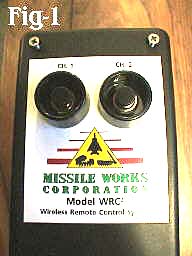 The Missile Works WRC² Wireless Recovery Controller is a sophisticated, radio operated, two channel event activation device for high power rocketry. The WRC² is most often used as a backup recovery deployment device. Other uses for the WRC² would include primary recovery deployment, ignition of clustered motors or second stage motor, operation of photographic equipment, or activation of a tracking agent or sound. The use of radio control in high power rocketry is not new; what is new is the advanced design and reliability of the WRC2.
The Missile Works WRC² Wireless Recovery Controller is a sophisticated, radio operated, two channel event activation device for high power rocketry. The WRC² is most often used as a backup recovery deployment device. Other uses for the WRC² would include primary recovery deployment, ignition of clustered motors or second stage motor, operation of photographic equipment, or activation of a tracking agent or sound. The use of radio control in high power rocketry is not new; what is new is the advanced design and reliability of the WRC2. 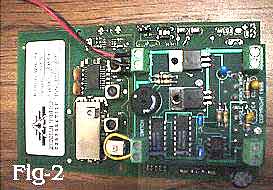 The WRC² consists of a hand held transmitter (Fig-1) with a 3 volt lithium battery, a receiver unit, (Fig-2) and instructions. The transmitter measures 8" L x 3" W x 2" H. A single 3 volt battery powers the unit. There is no power switch on the transmitter, there is virtually no power consumption unless one of the trigger buttons is pressed. The instructions suggest testing the voltage before each use, where 2.9 volts is the minimum acceptable voltage. It is also suggested that the battery be removed when the unit will not be used for an extended time Four screws need to be removed to access the battery, so I leave it installed most of the time. A short flexible antenna extends only a couple of inches from the antenna case.
The WRC² consists of a hand held transmitter (Fig-1) with a 3 volt lithium battery, a receiver unit, (Fig-2) and instructions. The transmitter measures 8" L x 3" W x 2" H. A single 3 volt battery powers the unit. There is no power switch on the transmitter, there is virtually no power consumption unless one of the trigger buttons is pressed. The instructions suggest testing the voltage before each use, where 2.9 volts is the minimum acceptable voltage. It is also suggested that the battery be removed when the unit will not be used for an extended time Four screws need to be removed to access the battery, so I leave it installed most of the time. A short flexible antenna extends only a couple of inches from the antenna case. 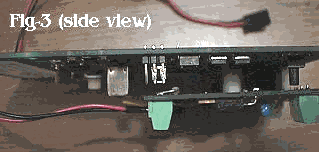 I built a 12 volt NiCad battery pack (Fig-5) using cordless phone 280ma. 3.6 volt battery packs (Fig-4). Three full packs plus one extra cell will yield 12 volts (10 cells at 1.2 volts each). I have been lucky to find some of these batteries on clearance at WalMart every time I've needed some. With my limited electronics background, setting up a charger for this battery pack was a trial and error process. I gathered up all my surplus AC adapters with a D.C. output of at least 12 volts and chose one which seemed to fully charge the battery overnight. I connected the battery to the receiver to make sure it would power it for a least one hour, which it did.
I built a 12 volt NiCad battery pack (Fig-5) using cordless phone 280ma. 3.6 volt battery packs (Fig-4). Three full packs plus one extra cell will yield 12 volts (10 cells at 1.2 volts each). I have been lucky to find some of these batteries on clearance at WalMart every time I've needed some. With my limited electronics background, setting up a charger for this battery pack was a trial and error process. I gathered up all my surplus AC adapters with a D.C. output of at least 12 volts and chose one which seemed to fully charge the battery overnight. I connected the battery to the receiver to make sure it would power it for a least one hour, which it did. 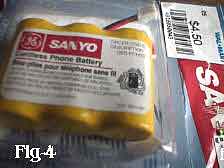 I came to high power rocketry after many years of flying radio control airplanes. The battery and receiver in a RC airplane are never firmly mounted in the fuselage, they are simply packed in foam. I have been using this same technique for electronics in my rockets. Just be sure all cables are long enough to compensate any shift of items during recovery. I asked Jim Amos of Missile Works if mounting the receiver in this manor would affect it's operation.
I came to high power rocketry after many years of flying radio control airplanes. The battery and receiver in a RC airplane are never firmly mounted in the fuselage, they are simply packed in foam. I have been using this same technique for electronics in my rockets. Just be sure all cables are long enough to compensate any shift of items during recovery. I asked Jim Amos of Missile Works if mounting the receiver in this manor would affect it's operation." It does not affect the unit whatsoever. That's the beauty of 900MHz and the frequency hopping. Chances are you wouldn't have adverse affect over every frequency between 902-928 MHz. We did some range testing prior to the Redstone shot at LDRS to see if laminated airframes had any affect on performance. There was a very 'slight' attenuation factor, but we were still operating well within specs. This electronics bay/airframe was full of wiring, aluminum brackets, all-thread, fasteners, (2) altimeters, 12V Nicad pack, and was laminated with wraps of 5oz CARBON and 2 wraps of 4oz GLASS."
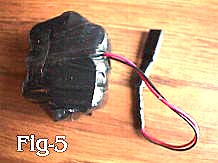 The WRC² system differs from other types of radio control equipment which are susceptible to interference from other types of radio activity in the area. The WRC² is designed to be operated under almost any condition; it is not necessary to have the transmitter impounded at large events. I asked Jim Amos how the WRC² achieves all this while having a two mile range, and such a short antenna?
The WRC² system differs from other types of radio control equipment which are susceptible to interference from other types of radio activity in the area. The WRC² is designed to be operated under almost any condition; it is not necessary to have the transmitter impounded at large events. I asked Jim Amos how the WRC² achieves all this while having a two mile range, and such a short antenna?
"When triggering an event with the WRC, the transmitter sends (24) 40-bit data packets via FSK (Frequency Shift Keying) at randomly spaced time intervals AND randomly chosen frequencies within that 902-928MHz band (quite a spectrum to choose from). Each packet is on a different frequency. The theory is that if one frequency can't make it through due to any external interference, another one other will. It's analogous to stopping at a traffic signal and noticing a 'dead spot' with your FM radio station. You could switch to another station (frequency) and have perfect reception, yet your original station (frequency) might be slightly 'browned out'. Included in a data packet are the 16 bits of your transmitter ID code. The balance of the message is used for error detection and packet sync. It works like your cell phone (with it's short stub of an antenna) which is also at 900 Mhz. High frequency 900MHz bands have very small wavelengths and thusly require very small antennas."
 I purchased the WRC² system for my level-3 certification launch planned for summer or fall of 2000. Most of my planning for the project has centered around the recovery and the different possible configurations. The WRC² was a part of most of the original designs and all of the most recent plans. Most likely, it will be used as the back up for the drogue deployment and the primary for the main chute deployment.
I purchased the WRC² system for my level-3 certification launch planned for summer or fall of 2000. Most of my planning for the project has centered around the recovery and the different possible configurations. The WRC² was a part of most of the original designs and all of the most recent plans. Most likely, it will be used as the back up for the drogue deployment and the primary for the main chute deployment.
Other Reviews
- Missile Works WRC2 (Wireless Recovery Controller) By Paul C. Smith (August 25, 2009)
About four years ago I got a WRC2 for a student rocketry contest. I've since flown it six times, most recently just a month ago, and it has worked perfectly each time. It's a real kick to be able to push a button and watch your rocket respond by kicking out the main parachute. Details: The WRC2 receiver (the onboard part) is quite large. I put mine in a 5.5" diameter rocket, and at 3.25" ...
Sponsored Ads
 |
 |











